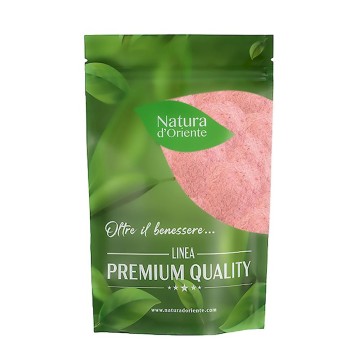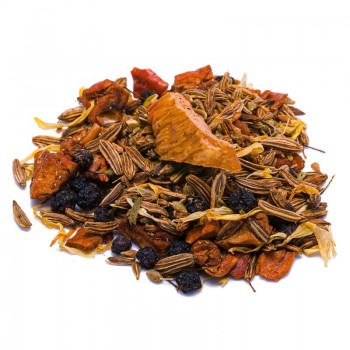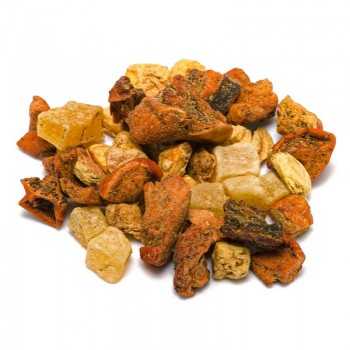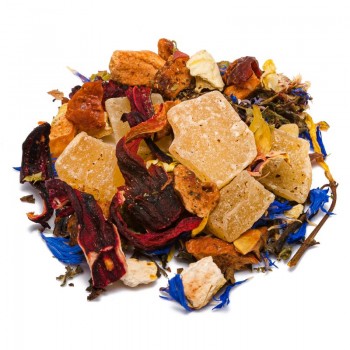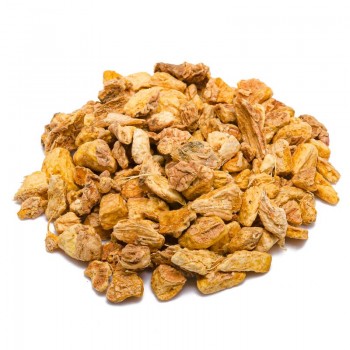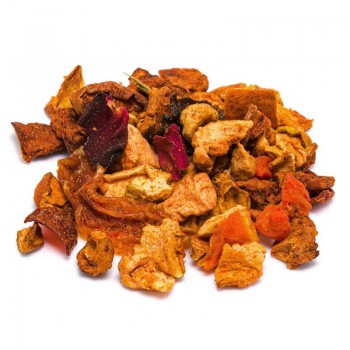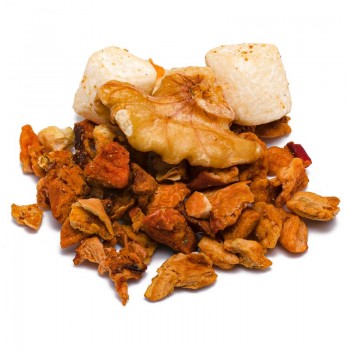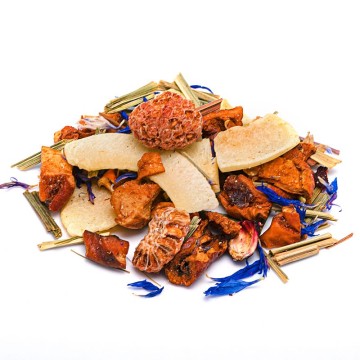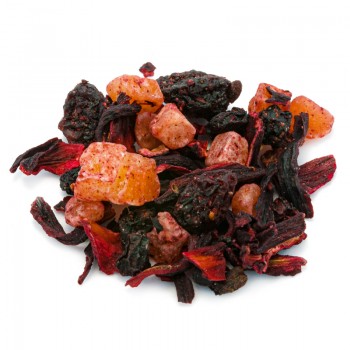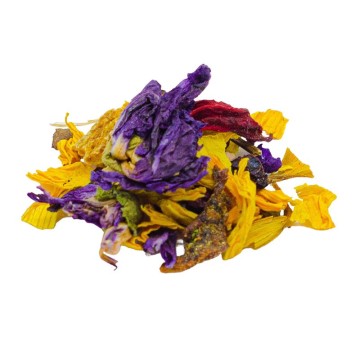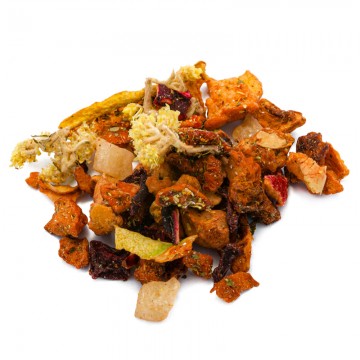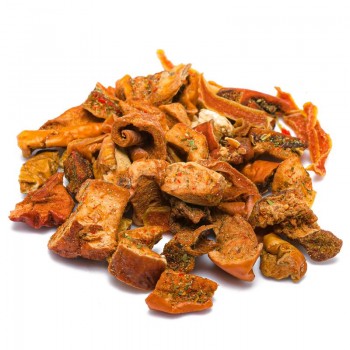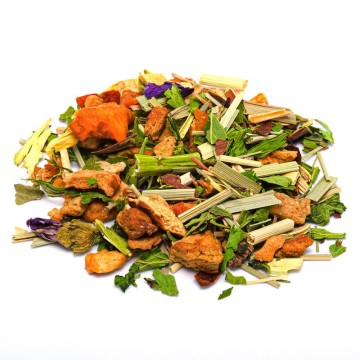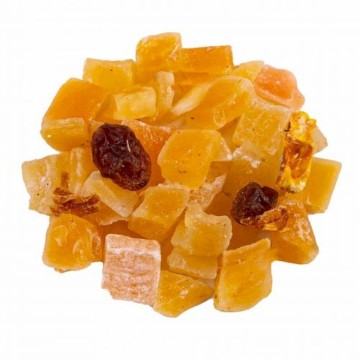The lively and tropical flavors of the fruits and the fruity acidity of the pomegranate combine with the floral notes of the hibiscus. The result is a flavor that evokes citrus fruits, a sort of non-alcoholic winter punch that in summer transforms into a fresh and thirst-quenching infusion. The explosion of flavors of exotic fruit and orange is well balanced by the nuances of apple and safflower. The infusion becomes sweet with notes of papaya and mango, and at the same time shows a wealth of nutrients.
Lemon, papaya and mango infusion: properties and benefits
All the elements of this fruit infusion are rich in beneficial natural substances. By taking this infusion our body obtains various vitamins including A, C, E, K, as an excellent mix of fruit and safflower seeds promises. The presence of papaya, mango, orange, hibiscus and pomegranate seeds ensures a supply of vitamins and precious liquids for hydration. Vitamin C and vitamin A function as potential antioxidants and together with other phytonutrients and phenolic compounds, strengthen the immune system and circulatory system tissues. Besides from a health point of view, vitamins also promote our beauty. We know that vitamin A is a nutrient necessary for the growth of all body tissues, including skin and hair. Adequate intake of vitamin C also helps build and maintain collagen, which provides structure to the skin. In terms of minerals, mango is rich in copper, zinc, phosphorus while papaya provides magnesium and iron (also present in pomegranate). Mango contains powerful antioxidants, phenols and ascorbic acid, as well as mangaferin – an antioxidant that fights free radicals and protects tissues from oxidative stress. These antioxidant properties return to pomegranate and papaya, which among other things contains an enzyme called papain which aids digestion - particularly of proteins. Mango and apple also stimulate regular bowel movements, thus reducing the risk of constipation and other gastrointestinal problems. The infusion thus promotes the intake of valuable nutrients and healthy digestive transit.
Origins and history of cultivation
The mango is native to India, and today grows mainly in Southeast Asia and parts of the Indian subcontinent. It has been a very popular fruit for centuries, as some of these countries use it in the diet to compensate for other nutrients (minerals, antioxidants and vitamins). It represents one of the tropical fruits linked to Hindu culture, and the mango tree appears in many Indian legends. The leaves were used for garlands intended for temples, to decorate ritual or wedding banquets. Its name, in fact, derives from the Indian Tamil phrase maangai, which in Portugal became "manga" and then mango.
The mango spread to East Asia in the 4th century BC. and to Africa in the 10th century via Arab merchants. It arrived in South America in the early seventeenth century, via the Portuguese. Today mango is cultivated in many tropical and subtropical countries, in Europe in Spain (Andalusia) and Sicily.
The fruit of the papaya (or pawpaw) is native to the American tropics and Central America - in particular Mexico, where the plant grew spontaneously and was called Chichihualtzapotl, meaning "fruit sweet from the nurse".
Appreciated since ancient times by local populations, it was linked to fertility as a tree of life. The Spanish spread it in the 16th century through its seeds, bringing them to the Caribbean and the Philippines, from where the papaya plant then reached India and Africa. Today the plant is grown in many tropical countries around the world, where temperatures do not drop below zero degrees. In Italy it is cultivated little in Sicily and Calabria, bearing fruit in spring - summer.
Fruits and flowers
The components of the infusion are many, and the mixture includes leaves and flowers of different origins.
The mango comes from a tree of the Mangifera genus, which has dozens of varieties including the evergreen plant Mangifera Indica. It commonly grows in all tropical areas, showing a resinous bark and rough red wood.
The leaves of the plant are pointed, the flowers bloom pinkish-white or yellowish, but not all of them bear mango fruits (few compared to the flowers). The fruits require three to six months to ripen, depending on the variety, and are yellow-reddish in color.
The Carica papaya is not a very treelarge member of the Caricaceae family. It shows little branching, and in some cases reaches up to 10 meters in height. It requires a warm or temperate temperature and the plant usually reaches the age of about 5 years. The flowers grow continuously, even at the same time as the fruits. The color of the fruits can have various shades between green, yellow, orange or pink. The papaya is large and can reach up to 30 cm and weigh up to 9 kg.
The Malus domestica plant of the Rosaceae family gives us apples. It is a tree native to Asia, now widespread throughout the planet. The fruits vary in color and in many varieties, and have been used in human nutrition for millennia. Orange is a fruit of various citrus species of the Rutaceae family. It mainly refers to Citrus × sinensis or sweet orange, to distinguish it from the related Citrus × aurantium, referred to as bitter orange.
Pomegranate trees, Punica granatum, produce fruits with red, leathery skin and sweet, edible seeds. The tree belongs to the Lythraceae family, native to the territory between Iran and the Himalayan chain.
Carthamus tinctorius is an annual and aromatic plant also known as saffron or false saffron. It is famous for the seeds and the oil extracted from them. It reaches a height of 1-1.4 meters and belongs to the Asteraceae family.
Hibiscus or hibiscus is a herbaceous plant, which belongs to the Malvaceae family. It is native to Asia, and usually the variety best known for its flowers is Hibiscus sabdariffa, from which drinks such as hibiscus tea are made by drying the calyxes of the flowers – large and colourful.
Nutritional values of the Lemon Papaya Mango infusion
The main active ingredients of the drink are vitamins (A, C, E, K). In terms of minerals, the infusion is rich in copper, zinc, phosphorus, iron and magnesium. Other beneficial groups are the antioxidant polyphenols, and substances such as papain and mangaferin.
How to use the ingredients in the infusion The infusion is obtained by inserting approximately 3-5 grams of the fruit mixture into a cup (250 ml) exotic products with water at 100 °C.
Leave it to infuse for 10 to 12 minutes before drinking the lemon, papaya and mango infusion. Add honey or sugar, if desired.
Lemon Papaya Mango infusion: side effects and contraindications
It is necessary to respect the recommended doses and not exceed the consumption of the infusion for too long periods. Excessive intake can cause diarrhea, headache, nausea and digestive difficulties.


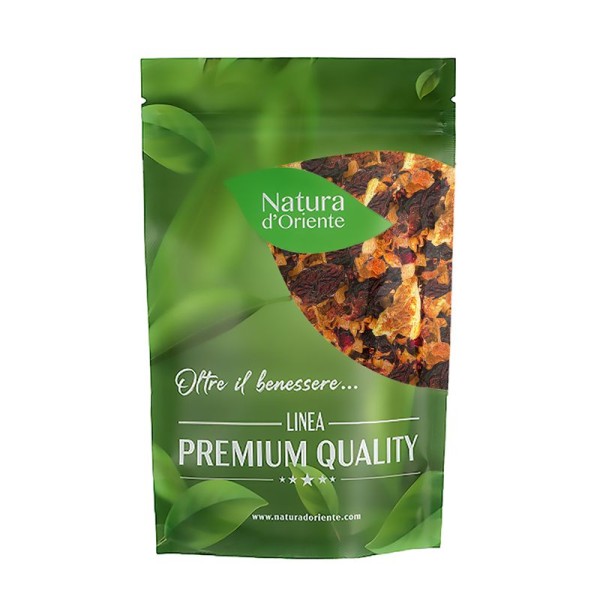








 No reward points for this product.
No reward points for this product.
